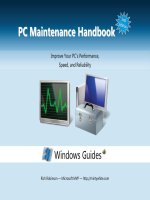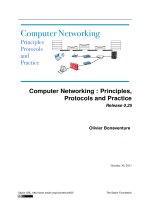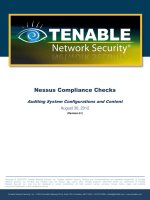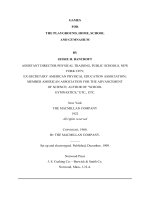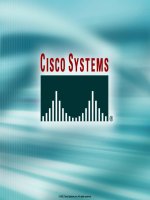Pragmatic Thinking and Learning pot
Bạn đang xem bản rút gọn của tài liệu. Xem và tải ngay bản đầy đủ của tài liệu tại đây (8.78 MB, 281 trang )
What people are saying about
Pragmatic Thinkin g and Learning
This book will be the catalyst for your future.
Patrick Elder
Agile Software Developer
By following Andy’s concrete steps, you can make your most pre-
cious asset—your brain—more efficient and productive. Read thi s
book, and do what Andy tells you to do. You’ll think smarter, work
better, and learn more t han ever before.
Bert Bates
Cocreator of Head First, Brain Friendly Books
I’ve always been looking for something to help me improve my
learning skills, but I’ve never found anything as effective as this
book. P ragmatic Thinking and Learning repr esents the best way
to help you become an expert learner, improve your skills, and
teach you how to improve your work efficiency by learning fast
and easily.
Oscar Del Ben
Software developer
I love books that explain that context matters. This book does—
and helps you understand why. From the Dreyfus model (a source
of many “aha’s” for me) to explaining why experiential training
works (the wall climbing story), Andy writes with humor and with
tact so you can learn from reading and organize your own think-
ing and learning.
Johanna Rothman
Consultant, author and speaker
Prepared exclusively for Jose Luis Loya
gggggggggggggggg
This is an accessible and insightful book that will be useful to
readers in many fields. I enjoyed reading it!
Dr. Patricia Benner
Professor and Chair, Department of Social and Behavioral
Sciences, University of California, San Francisco
Finished reading the beta last night. I loved this talk at NFJS
(and the herding racehorses one), and to have it in book form—
spectacular. All of this material has really changed my life!
Matt McKnight
Software developer
This has been fun, and I’ve learned a lot—can’t ask for
more than that.
Linda Ri sing
International speaker, consultant, and object-oriented
expert
Pragmatic Thin k ing and Learning
Refactor Your “Wetware”
Andy Hunt
The Pragmatic Bookshelf
Raleigh, North Carolina Dallas, Texas
Many of the designations used by manufacturers and sellers to distinguish their
products are claimed as trademarks. Where those designations appear in this book,
and The Pragmatic Programmers, LLC was aware of a trademark claim, the desig-
nations have been printed in initial capital letters or in all capitals. The Pragmatic
Starter Kit, The Pragmatic Programmer, Pragmatic Programming, Pragmatic Book-
shelf and the linking g devic e are trademarks of The Pragmatic Programmers, LLC.
Information contained in this book is intended as an educational aid only. Infor-
mation is not intended as medic al advice for any individual condition or treatment,
and is not a substitute for professional medical care.
Every precaution was taken in the preparation of this book. However, the publisher
assumes no responsibility for errors or omissions, or for damages that may result
from the use of information (including program listings) contained herein.
Our Pragmatic courses, workshops, and other products can help y ou and your team
create better software and have more fun. For more information, as well as the latest
Pragmatic titles, please visit us at
Copyright
©
2
008 Andy Hunt.
All rights reserved.
No part of this publication may be reproduced, stored in a retrieval system, or
transmitted, in any form, or by any means, electronic, mec hanical, photocopying,
recording, or otherwise, without the prior consent of the publisher.
Printed in the United States of America.
ISBN-10: 1-934356-05-0
ISBN-13: 978-1-934356-05-0
Printed on acid-free paper.
P2.0 printing, January 2009
Version: 2009-3-4
Prepared exclusively for Jose Luis Loya
gggggggggggggggg
For my wife and children,
and for everyone who becomes what they think.
C
ONTENTS
8
Report erratum
this copy is (P2.0 printing, January 2009)
Prepared exclusively for Jose Luis Loya
gggggggggggggggg
ONTENTS
9
Report erratum
this copy is (P2.0 printing, January 2009)
Prepared exclusively for Jose Luis Loya
gggggggggggggggg
Contents
1 Introduction 13
1.1 Again with the “Pragmatic”? . . . . . . . . . . . . . . 16
1.2 Consider the Context . . . . . . . . . . . . . . . . . . 17
1.3 Everyone Is Talking About This Stuff . . . . . . . . . 18
1.4 Where We’re Going . . . . . . . . . . . . . . . . . . . 19
1.5 Grateful Acknowledgments . . . . . . . . . . . . . . 23
2 Journey from Novice to Expert 25
2.1 Novices vs. Experts . . . . . . . . . . . . . . . . . . . 27
2.2 The Five Dreyfus Model Stages . . . . . . . . . . . . 29
2.3 Dreyfus at Work: Herding Racehorses and Racing
S
heep . . . . . . . . . . . . . . . . . . . . . . . . . . . 37
2.4 Using the Dreyfus Model Effectively . . . . . . . . . 43
2.5 Beware the Tool Trap . . . . . . . . . . . . . . . . . . 50
2.6 Consider the Context, Again . . . . . . . . . . . . . . 53
2.7 Day-to-Day Dreyf us . . . . . . . . . . . . . . . . . . . 55
3 This Is Your Brain 57
3.1 Your Dual-CPU Modes . . . . . . . . . . . . . . . . . 58
3.2 Capture Insight 24x7 . . . . . . . . . . . . . . . . . . 63
3.3 Linear and Rich Characterist i cs . . . . . . . . . . . . 67
3.4 Rise of the R-
mode . . . . . . . . . . . . . . . . . . . 75
3.5 R-
mode Sees Forest; L-mode Sees Trees . . . . . . . 80
3.6 DIY Brain Surgery and Neuroplasticity . . . . . . . . 82
3.7 How Do You Get There? . . . . . . . . . . . . . . . . 83
4 Get in Your Right Mi nd 85
4.1 Turn Up the Sensory Input . . . . . . . . . . . . . . 85
4.2 Draw on the Right Side . . . . . . . . . . . . . . . . . 87
4.3 Engage an R-
mode to L-mode Flow . . . . . . . . . . 92
4.4 Harvest R-mode Cues . . . . . . . . . . . . . . . . . 104
4.5 Harvesting Patterns . . . . . . . . . . . . . . . . . . . 114
4.6 Get It Right . . . . . . . . . . . . . . . . . . . . . . . . 122
Prepared exclusively for Jose Luis Loya
gggggggggggggggg
CONTENTS 11
5 Debug Your Mind 124
5.1 Meet Your Cognitive Biases . . . . . . . . . . . . . . 126
5.2 Recognize Your Generational Affinity . . . . . . . . . 134
5.3 Codifying Your Personality Tendencies . . . . . . . . 144
5.4 Exposing Hardware Bugs . . . . . . . . . . . . . . . 147
5.5 Now I Don’t Know What to Think . . . . . . . . . . . 151
6 Learn Deliberately 155
6.1 What Learning Is and Isn’t . . . . . . . . . . . . . . 155
6.2 Target SMART Objectives . . . . . . . . . . . . . . . 159
6.3 Create a Pragmatic Investment Plan . . . . . . . . . 164
6.4 Use Your Primary Learning Mode . . . . . . . . . . . 168
6.5 Work Together, Study Together . . . . . . . . . . . . 174
6.6 Use Enhanced Learning Techniques . . . . . . . . . 176
6.7 Read Deliberately with SQ3R . . . . . . . . . . . . . 177
6.8 Visualize Insight wit h Mind Maps . . . . . . . . . . . 181
6.9 Harness the Real Power of Documenting . . . . . . 188
6.10 Learn by Teaching . . . . . . . . . . . . . . . . . . . 190
6.11 Take It to the Streets . . . . . . . . . . . . . . . . . . 192
7 Gain Experience 193
7.1 Play in Order to Learn . . . . . . . . . . . . . . . . . 193
7.2 Leverage Existing Knowledge . . . . . . . . . . . . . 197
7.3 Embed Failing in Practice . . . . . . . . . . . . . . . 199
7.4 Learn About the Inner Game . . . . . . . . . . . . . 203
7.5 Pressure Kills Cognition . . . . . . . . . . . . . . . . 208
7.6 Imagination Overrides Senses . . . . . . . . . . . . . 212
7.7 Learn It like an Expert . . . . . . . . . . . . . . . . . 216
8 Manage Focus 218
8.1 Increase Focus and Attention . . . . . . . . . . . . . 219
8.2 Defocus to Focus . . . . . . . . . . . . . . . . . . . . 225
8.3 Manage Your Knowledge . . . . . . . . . . . . . . . . 228
8.4 Optimize Your Current Context . . . . . . . . . . . . 235
8.5 Manage Interruptions Deliberately . . . . . . . . . . 241
8.6 Keep a Big Enough Context . . . . . . . . . . . . . . 248
8.7 How to Stay Sharp . . . . . . . . . . . . . . . . . . . 252
Report erratum
this copy is (P2.0 printing, January 2009)
Prepared exclusively for Jose Luis Loya
gggggggggggggggg
CONTENTS 12
9 Beyond Expertise 253
9.1 Effective Change . . . . . . . . . . . . . . . . . . . . . 253
9.2 What to Do Tomorrow Morning . . . . . . . . . . . . 255
9.3 Beyond Expertise . . . . . . . . . . . . . . . . . . . . 256
A Photo Credits 260
B Bibliography 261
Index 271
Report erratum
this copy is (P2.0 printing, January 2009)
Prepared exclusively for Jose Luis Loya
gggggggggggggggg
Chapter 1
Introduction
Welcome!
Thanks for picking up this book. T oget her, we’re going t o journey
through bits of cognitive science, neuroscience, and learning and
behavioral theory. You’ll see surpr i sing aspects of how our brain s
work and see how you can beat the system to improve your own
learning and thinking skills.
We’re going to begin to refactor your wetware—redesign and rewire
your brain—to make you more effective at your job. Whether you’re
a programmer, manager, “knowledge worker,” t echnogeek, or deep
thinker, or if you just happen to have a human brain you’d like to
crank up, this book will help.
I’m a programmer, so my examples an d rants will be directed at the
world of software development. If you’re not a programmer, don’t
worry; programming really has little to do with writing software in
arcane, cryptic languages (although we have a curious attachment
to that habit).
Programming is all about problem solving. It requires creativity,
ingenuity, and invention. Regardless of your profession, you prob-
ably also have to solve problems creatively. However, for program-
mers, combining ri ch , flexible human thought with the rigid con-
straints of a digital computer exposes the power and the deepest
flaws of both.
Whether you’re a programmer or frustrated user, you may have
already suspected that software development must be the most
difficult endeavor ever envisioned and practiced by humans. Its
complexity strains our best abilities daily, and failur es can often
Prepared exclusively for Jose Luis Loya
gggggggggggggggg
CHAPTER 1. INTRODUCTION 14
be spectacular—and newsworthy. We’ve smashed spaceships into
distant planets, blown up expensive rockets filled with irreplace-
able experiments, plagued consumers with automated collection
letters for $0.00, and stranded airline travelers on a semiregular
basis.
But now the good news (sort of): it’s all our fault. We tend t o make
programming much harder on ourselves than we need. Because of
the way the industry has evolved over time, it seems we’ve lost track
of some of the most fundamental, most important skills needed by
a software developer.
The good news is that we can fix that right here and right now. This
book will help show you how.
The number of bugs programmers introduce i nto programs has
remained constant for the past forty years. Despite advances in
programming languages, techniques, project methodologies, and
so on, the defect density has remained fairly constant.
1
Maybe that’s because we’ve been focusing on the wrong things.
Despite all these obvious changes in technology, one thing has
remained constant: us. Developers. People.
Software isn’t designed in an IDE or other tool. It’s imagined and
created in our heads.
Software is created in
your head.
Ideas and concepts are shared and com-
municated among a team, including the
folks who are paying our organization to
develop this software. We’ve spent the time
investing in basic technology—in languages, tools, methodologies.
That was time well spent, but now it’s time to move on.
Now we need to look at the really hard problems of social interac-
tion in and betw een teams and even at the harder issues of just
plain old th i nking. No project is an island; software can’t be built
or perform in isolation.
Frederick Brooks, in his landmark paper “No Silver Bullet–Essence
and Accident in Software Engineering” [
Bro86], claimed that “the
s
oftware product is embedded in a cultural matrix of applications,
1. Based on research by Capers Jones via Bob Binder.
Report erratum
this copy is (P2.0 printing, January 2009)
Prepared exclusively for Jose Luis Loya
gggggggggggggggg
CHAPTER 1. INTRODUCTION 15
users, laws, and machine vehicles.
2
These all change continually,
and their changes inexorably force change upon the software
product.”
Brooks’ observation puts us squarely at the center of the mael-
strom of society itself. Because of this complex interaction of many
interested parties and forces and the constant evolution of change,
it seems to me that the two most important modern skills are these:
• Communication skills
• Learning and thinking skills
Some improvement to communication skills is being addressed by
our industry. Agile methods (see the sidebar on the following page),
in particular, emphasize improved communications between t eam
members and between the ultimate customer and the development
team. Mass-media books such as Presentation Zen: Simple Ideas on
Presentation Design and Delivery [Rey08] are suddenly best-sellers
a
s more and more people realize the importance of simple, effective
communication. It’s a good start.
But then there’s learning and thinking, whi ch is a much harder
nut to crack.
Programmers have to learn constantly—not just the ster eoty pical
new technologies but also the problem domain of the application,
the whims of the user community, the quirks of their teammates,
the shifting sands of th e industry, and the evolving characteristics
of the project itself as it is built. We h ave to learn—and relearn—
constantly. Then we have t o apply this learning to the daily barrage
of both old and new problems.
It sounds easy enough in principle perhaps, but learn i ng, criti-
cal thinking, creativity, and invention—all those mind-expanding
skills—are all up to you. You don’t get taught; you have to learn .
We tend to look at t he teacher/learner relationship the wrong way
around: it’s not that the teacher teaches; it’s that the student
learns. The learning is always up to you.
It’s my hope that Pragmatic Thinking and Learning can help guide
you through accelerated and enhanced learning and more prag-
matic thinking.
2. That is, platforms.
Report erratum
this copy is (P2.0 printing, January 2009)
Prepared exclusively for Jose Luis Loya
gggggggggggggggg
AGAIN WITH THE “PRAGMATIC”? 16
What Are Agile Methods?
The term agile methods was coined at a summit meet-
ing in February 2001 by seventeen leaders in software
development, including the founders of various devel-
opment methodologies such as Extreme Programming,
Scrum, Crystal, and, of course, our very own pragmatic
programming.
Agile methods differ from traditional plan-ba sed methods
in a number of significant ways, most notably in eschewing
rigid rules and discarding dusty old schedules in favor of
adapting to real-time feedback.
I’ll talk about agile methods often throughout the b ook,
because many of the agile ideas and practices fit in well
with good cognitive habits.
1.1 Again with the “Pragmatic”?
From the original The Pragmatic Programmer: From Journeyman to
Master [
HT00] to our Pragmatic Bookshelf publishing imprint, you
w
ill notice that we have a certain preoccupation with the word prag-
matic. The essence of pragmatism is to do what works—for you.
So before we begin, please bear in mind that every individual is
different. Although many of the studies that I’ll reference have
been conducted on large populations, some have not. I’m going
to draw on a large variety of material ranging from hard scientific
fact proven with functional MRI scans of the brain to conceptual
theories, as well as material ranging from old wives’ tales to “Hey,
Fred tried it, and it worked for him.”
In many cases—especially when discussing the brain—the under-
lying scientific reasons are unknown or unknowable. But do not
let that worry you: if it works, then it’s pragmatic, and I will offer
it here for your consideration. I hope many of these ideas will work
for you.
Only dead fish go with
the flow.
But some folks are just plain wired dif-
ferently; you may be one of them. And
that’s OK; you shouldn’t follow any advice
blindly. Even mine. Instead, read with an
open mind. Try the suggestions, and decide what works for you.
Report erratum
this copy is (P2.0 printing, January 2009)
Prepared exclusively for Jose Luis Loya
gggggggggggggggg
CONSIDER THE CONTEXT 17
What Is Wetware?
wet•ware |
|
wet
|
we(
e
)r|: etymology: wet + software
Noun, humorous. Human brain cells or thought processes
regarded as analogous to, or in contrast with, computer
systems.
That is, using the model of a computer as an analogy to
human thought processes.
As you grow and adapt, you may need to modify your habits and
approaches as well. Nothing in life is ever static; only dead fish go
with the flow. So, please take this book as just the beginning.
I’ll share the pragmatic ideas and techniques I’ve found in my jour-
ney; the rest is up to you.
1.2 Consider the Context
Everything is interconnected: the physical world, social systems,
your innermost thoughts, the unrelenting logic of the computer—
everything forms one immense, interconnected system of reality.
Nothing exists in isolation; everything is part of the system and
part of a larger context.
Because of that inconvenient fact of reality, small things can have
unexpectedly large effects. That disproportionate effect is the hall-
mark of nonlinear systems, and in case you hadn’t noticed, t he real
world is decidedly nonlinear.
When we try to pick out anything by itself, we find it hitched to
e
verything else in the universe.
John Muir, 1911, My First Summer in the Sierra
Throughout this book, you’ll find activities or differences that seem
to be so subtle or inconsequential that they couldn’t possibly make
a difference. These are activities such as thinking a thought to
yourself vs. speaking it out loud or such as writing a sentence
on a piece of paper vs. typing it into an editor on the computer.
Abstractly, these things should be perfectly equivalent.
But they aren’t.
Report erratum
this copy is (P2.0 printing, January 2009)
Prepared exclusively for Jose Luis Loya
gggggggggggggggg
EVERYONE IS TALKING ABOUT THIS STUFF 18
These kinds of activities utiliz e very different pathways i n the
brain—pathways that are affected by your very thoughts and h ow
you think them. Your thoughts are not disconnected from the rest
of the brain machinery or your body; it’s all connected. This is just
one example (and we’ll talk more about the brain later in the book),
but it helps ill ustrate the importance of thinking about in teracting
systems.
Everyt hing is
interconnected.
In his seminal book The Fifth Discipline:
The Art and Practice of the Learning Orga-
nization [
Sen90], Peter Senge popularized
t
he term systems thinking to describe a
different approach of viewing the world. In systems thinking, one
tries to envision an object as a connection point of several systems,
rather than as a discrete object unto itself.
For instance, you might consider a tree to be a single, discrete
object sitting on the visible ground. But in fact, a tree is a connec-
tion of at least two major systems: the processing cycle of leaves
and air and of roots and earth. It’s not static; it’s not isolated. And
even more interesting, you’ll rarely be a simple observer of a sys-
tem. More likely, you’ll be part of it, whether you know it or not.
3
TIP 1
Always consider the context.
Put a copy of that up on your wall or your desktop, in your con-
ference room, on your whiteboard, or anywhere you think alone or
with others. We’ll be returning to it.
1.3 Everyone Is Talki ng About This Stuff
As I was mulling over the idea of writing this book, I started to
notice t hat a lot of people in different disciplines were talking about
the topics in which I was interested. But th ese were in very different
and diverse areas, including the following:
• MBA and executive-level training
• Cognitive science research
3. Suggested by our old buddy Heisenberg and his quantum uncertainty principle,
the more general observer effect posits that you can’t observe a syste m without
altering it.
Report erratum
this copy is (P2.0 printing, January 2009)
Prepared exclusively for Jose Luis Loya
gggggggggggggggg
WHERE WE’RE GOING 19
• Learning theory
• Nursing, health care, aviation, and other professions and
industries
• Yoga and meditative practices
• Programming, abstraction, and problem solving
• Artificial intelligence research
There’s something
fundamental here.
When you start to find th e same set
of ideas—the same common threads—
showing up in different guises in these
very different areas, that’s usually a sign.
There must be something fundamental and very important lurking
under the covers for these similar ideas to be present in so many
different contexts.
Yoga and meditative techniques seem to be enjoying quite a bit of
mainstream popularity these days, and not always for obvious rea-
sons. I noticed an article in an in-flight magazine around October
2005 that t rumpeted the headline “Companies Now Offering Yoga
and Meditation to Help Fight Rising Health-Care Costs.”
Large companies have not historically embraced such warm-and-
fuzzy activities. But the meteoric rise of health-care costs has
forced them to take any course of action that might help. Clearly,
they believe the studies showing that practitioners of yoga an d
meditative techniques enjoy greater overall health than the general
population. In this book, we’re more interested in the areas related
to cognition, but greater overall health is a nice side benefit.
I also noticed that a number of MBA and executive-level courses
promote various meditative, creative, and in tuitive techniques—
stuff that fits in perfectly with the available research but that has
not yet been passed down to the employees in the trenches, includ-
ing us knowledge-worker types.
But not to worry, we’ll be covering these topics here for you. No
MBA required.
1.4 Where We’re Going
Every good journey begins with a map, and ours appears in the
front portion of this book. Despite the linear flow of a book, these
topics are entwined and interrelated, as the map shows.
Report erratum
this copy is (P2.0 printing, January 2009)
Prepared exclusively for Jose Luis Loya
gggggggggggggggg
WHERE WE’RE GOING 20
After all, everything is connected to everything else. But it’s some-
what difficult to appreciate that idea with a linear read of a book.
You can’t always get a sense of what’s related wh en faced with
countless “see also” references in the text. By presenting the map
graphically, I hope y ou get the opportunity to see what’s related to
what a little more clearly.
With that in mind, the following is roughly where we are headed,
despite a few side trips, tangents, and excursions on the way.
Journey from Novice to Expert
In the first part of the book, we’ll look at w
hy your brain wor ks as
it does, beginning with a popular model of expertise.
The Dreyfus model of skill acquisition provides a powerful way of
looking at how y ou move beyond beginner-level performance and
begin the journey to mastery of a skill. We’ll take a l ook at the Drey-
fus model and in particular look at the keys to becoming an expert:
harnessing and applying your own experience, understanding con-
text, and harnessing intuition.
This Is Your Brain
The most important tool in software development is, of course
,
your own brain. We’ll take a look at some of the basics of cog-
nitive science and neuroscience as th ey relate to our interests as
software developers, including a model of the brain that looks a lot
like a dual-CPU, shared-bus design and how to do your own brain
surgery of a sort.
Get in Your Right Mind
Once we have a better understanding of the brain, w e will find wa
ys
to exploit underutilized facets of thi nking to help encourage bet-
ter creativity and problem solving, as well as harvest and process
experiences more effectively.
We’ll also take a look at where intuition comes from. Intuition, the
hallmark of the expert, turns out to be a tricky beast. You need
it, you rely on it, but you also probably fight against using it con-
stantly, without knowing why. You may also be actively suspicious
of your own and others’ in tuition, mistakenly thinking th at it’s “not
scientific.”
We’ll see how to fix that and give your intuition freer reign.
Report erratum
this copy is (P2.0 printing, January 2009)
Prepared exclusively for Jose Luis Loya
gggggggggggggggg
WHERE WE’RE GOING 21
Debug Your Mind
Intuition is a fantastic skill, except when it’s w rong. There are a
large number of “known bugs” in human thinking. You have built-
in biases in your cognition, influences from when you’re born and
from your cohort (those born about the same time as you), your
innate personality, and even hardware wiring problems.
These bugs in th e system often mislead you by clouding your judg-
ment and steering you toward bad, even disastrous, decisions.
Knowing these common bugs is the first step to mitigating them.
Learn Deliberately
Now that w e’ve gotten a good look at how the brain works, we’ll
s
tart taking a more deliberate look at how to take advantage of the
system, beginning with learning.
Note that I mean learning in the broadest sense, covering not only
new technologies, programming languages, and the like, but also
your learnin g of the dynamics of the team you’re on, the character-
istics of the evolving software you’re building, and so on. In these
times, we have to learn all the time.
But most of us have never been taught how, so we sort of wing
it as best we can. I’ll show you some specific techniques to help
improve your learning ability. We’ll look at planning techniques,
mind maps, a reading technique known as SQ3R, and the cogni-
tive importance of teaching and writing. Ar med with these tech-
niques, you can absorb new information faster and easier, gain
more insights, and retain this new knowledge better.
Gain Experience
Gaining experience is key to your learnin g and growth—we lear
n
best by doing. However, just “doing” alone is no guarantee of suc-
cess; you have to learn from the doing for it to count, and it turns
out that some common obstacles make this hard.
You can’t force experience either; trying too hard can be just as
bad (if not worse) than slogging through the same old motions.
We’ll take a l ook at what you need to create an efficient learning
environment using feedback, fun, and failure; see the dangers of
deadlines; and see how to gain experience virtually with mental
grooving.
Report erratum
this copy is (P2.0 printing, January 2009)
Prepared exclusively for Jose Luis Loya
gggggggggggggggg
WHERE WE’RE GOING 22
Manage Focus
Managing your attenti on and focus is the n ext critical step in your
journey. I’ll share with you some tricks, tips, and pointers to help
you manage the flood of knowledge, information, and insights that
you need to gain experience and learn. We live in information-rich
times, and it’s easy to get so swamped under the daily demands of
our jobs that we have no chance to advance our careers. Let’s try
to fix that and increase your attention and focus.
We’ll take a look at how to optimize your current context, manage
those pesky interruptions better, and see w hy interruptions are
such cognitive train wrecks. We’ll look at why you need to defocus
in order to focus better in the mental marinade and manage your
knowledge in a more deliberate manner.
Beyond Expertise
Finally, we’ll take a quick look at wh y change is harder than it
l
ooks, and I’ll offer suggestions for what y ou can do tomorrow
morning to get started.
I’ll share what I think lies beyond expertise and how to get there.
So, sit back, grab your f avorite beverage, and let’s take a look at
what’s under the hood.
Next Actions
Throughout the book, I’ll suggest “next actions” that you can take
to help reinforce and make t his material real for you. These might
include exercises to do, experiments to try, or habits to start. I’ll list
these using checkboxes so you can check the items you’ve done,
like this:
✷ Take a hard look at curr en t problems on your project. Can you
spot the different systems i nvolved? Where do they interact?
Are these interaction points related to the problems you’re
seeing?
✷ Find th ree things you’ve analyzed out of context that caused
you problems later.
✷ Put up a sign somewhere near your monitor that reads “Con-
sider the context.”
Report erratum
this copy is (P2.0 printing, January 2009)
Prepared exclusively for Jose Luis Loya
gggggggggggggggg
GRATEFUL ACKNOWLEDGMENTS 23
About the Figures
You may notice that figures in this book don’t look like the
typical shiny, mecha nically perfect drawings you’d expect
from Adobe Il lustrator or something similar. That’s quite
deliberate.
From the electronics books by Forrest M. Mims III to the
back-of-the-napkin design documents favored by agile
developers, hand-drawn figures have certain unique prop-
erties, an d we’ll see why a bit later in the book.
1.5 Grateful Acknowledgments
Very special thanks to Ellie Hunt for introducing me to the Drey-
fus model and r elated nursing research, sufferin g th rough my dis-
jointed and rambling prose, keeping me on track, and keeping our
domestic enterpri ses running like a well-oiled machine. A regular
editor’s j ob is often difficult and thankless, and mere appreciation
in a preface really doesn’t do it justice. To be editor, mom, and
business manager all at once truly takes skill and patience.
Thanks to my friends on the Pragmatic Wetware mailing list
and reviewers, including Bert Bates, Don Gray, Ron Green,
Shawn Hartstock, Dierk Koenig, Niclas Nilsson, Paul Oakes, Jared
Richardson, Linda Rising, Johanna Rothman, Jeremy S ydik, Steph
Thompson, Derek Wade, and everyone else who posted their
thoughts, experiences, and readings. Their combined experiences
are invaluable.
Special thanks to June Kim for his many contributions throughout
the book, including pointers to far-flung research and stori es of h i s
own experiences, as well as his feedback throughout the stages of
birthing this book.
Special thanks also to Dr. Patricia Benner, who introduced the
Dreyfus model of skills acquisition to the nursing profession, for
her support and permission to quote from her works and for her
enthusiasm for learning.
Thanks go to Dr. Betty Edwards, who pioneered the practical appli-
cations of lateral specialization in the brain , for her kind support
and permission to quote from her works.
Report erratum
this copy is (P2.0 printing, January 2009)
Prepared exclusively for Jose Luis Loya
gggggggggggggggg
GRATEFUL ACKNOWLEDGMENTS 24
Thanks to Sara Lynn Eastler for the index, to Kim Wimpsett for
correcting my many typos and often h aphazard grammar, and to
Steve Peter for implementing a plethora of typesetting tricks.
And finally, than ks to you for purchasing this book an d beginning
the journey with me.
Let’s move our profession for ward in the right direction, harness
our experience and intuition, and create new environments where
learning matters.
Report erratum
this copy is (P2.0 printing, January 2009)
Prepared exclusively for Jose Luis Loya
gggggggggggggggg
